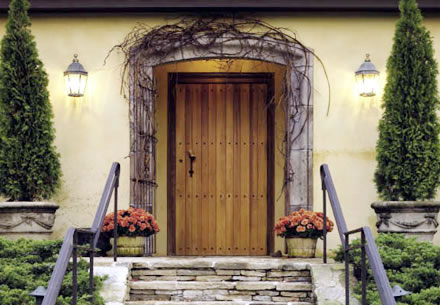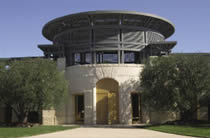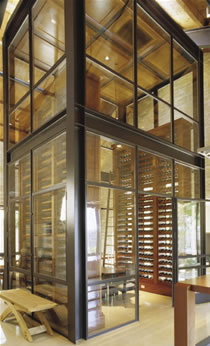Feature Article from the January 2009 Magazine Issue
Architecture and the Bottom Line
How much--and in what ways--do the aesthetics of a winery design pay off?
by Suzanne Gannon

Winemaker Roman Roth says the 200-pound door at Wolffer Estate Vineyard reflects the formidable wines he makes inside. "You just can't make a tooty-fruity wine behind that door," he says.
HIGHLIGHTS
- Winery architecture has become an art of its own in recent decades.
- Many wine country visitors are as interested in the architecture as they are in the wine.
- The structure must fit the site and perform the required functions.
- The cost of constructing a landmark may require significant financing.
In November 1995, after the wines of Christian Wolffer's Sagpond Vineyards began popping up in five-star restaurants throughout the New York metropolitan area, he decided that the old metal barn that housed his winery adjacent to his horse farm in Sagaponack, Long Island, was due for an upgrade.
He hired Marren and Newman, a New York architecture firm, and Bob Walker, an interior designer whose work he had encountered in Aspen, Colo. By 1997, the winery was freshly installed in a gracious ocher-colored edifice reminiscent of the wineries of Europe--and Tuscany in particular. At the same time, the winery rebranded itself as Wolffer Estate Vineyard."It starts with opening the 200-pound door," said Roman Roth, Wolffer's winemaker since 1992. "You can't just make a tooty-fruity wine behind that door. It would be an empty shell if the quality of the vineyard and the wine did not match that building."
After entering the winery through the dramatic doorway, visitors move to a tasting room with vaulted ceilings supported by massive reclaimed beams, terracotta tiles, chandeliers and sconces, 24-inch-thick walls and commodius tables for tasting wine. A collection of ornate 18th century steins, some of them valued at as much as $12,000, decorates one wall, and large pieces of art accent the space throughout.
"If you know you want to achieve a certain style, then you must take every step toward that style," Roth said. He added that the winery began purchasing most of its mechanical equipment for the new winery prior to the start of construction. "There's no point in coming up with a dream idea if it's not practical."
A large glass window overlooks the vinification tanks, symbolizing Wolffer's taste for transparency. "We have no secrets," Roth said.
French doors open onto a generous canopied terrace where guests can taste wine at large wooden tables overlooking rows of Chardonnay and Merlot vines. Plates of cheese and charcouterie are available to accompany wine flights.
"We would not have been able to go to 22,000 cases if we had not planned for it," Roth added, alluding to the winery's production growth from 12,000 cases in the early 1990s.
In winemaking communities across the continent, vintners and winery owners are keying into the appeal of a winery that is designed both to function well and be aesthetically pleasing. Not only does such a structure facilitate a memorable experience in hospitality, but if the architecture is notable enough, it can serve as a draw to consumers with an appetite for design as well as wine, subtly communicating a message of quality on behalf of the brand.
Building a Napa landmark
It could be said that Craig and Kathryn Hall of Hall Napa Valley in Rutherford and St. Helena have placed some substantial bets on architecture as a driver for a discerning set of wine consumers.
When developing the concept for the Rutherford winery, Kathryn Hall, who served as the U.S. ambassador to Austria during the Clinton administration, sought to make a connection between the winery and the country of her diplomatic posting. She hired renowned Austrian mason Friederich Gruber and his team to hand-build 14,000 square feet of vault-like cellars. They worked meticulously for five months, finishing it with reclaimed Austrian brick. A dramatic chandelier by New York artist Donald Lipski evokes an elaborately rooted tree laden with Swarovski crystals.
While in the final stages of completing the Rutherford winery, the Halls purchased the old Napa Valley Co-op in St. Helena, which dates to 1885 and reached its peak in the 1930s and 1940s, when it produced as much as 40% of the wines from Napa Valley growers.
Almost immediately the Halls, who are collectors of contemporary art and admirers of modern architecture, commissioned internationally renowned architect Frank Gehry to design a hospitality center on the historic site, and the Lail Design Group of St. Helena to design the production facilities. Though the winery does not disclose the value of its investment in the project, it has been reported at more than $100 million.
"We are trying to create a place that includes a spectacular winemaking facility, and to develop a unique and memorable experience in art, architecture and wine," said Hall Napa Valley president Mike Reynolds, who has been intimately involved in the design and construction of both facilities since joining the company six years ago.
Describing the process as "constant and relentless," Reynolds said the key to the success of the projects has been the interactive, collaborative relationship the winery team shares with the architects and engineers involved.

A large number of visitors to Napa Valley's Opus One winery are drawn in by its memorable setting, according to the hospitality team.
Design and permitting on the St. Helena site took about three years, and the Halls broke ground last summer, first constructing the two production buildings. In August they received their certificate of occupancy, enabling them to produce their fir
st vintage in the facility with the 2008 harvest. Solar panels have been incorporated into the production facilities, and the project currently is designed to qualify for LEED certification at the gold level.
Gehry's hospitality center, the later phase of the project, is currently under construction and slated for completion some time in 2011. An undulating wood trellis will float above the glass building.
"The trellis is meant to tie the agricultural nature of wine to the more modern architecture of Frank Gehry," Reynolds said.
Funding ambitious architecture
With marquee architectural names like Frank Gehry entering the mix, raising funds for design and construction is no small feat. And while many of the vintners interviewed for this article are loath to disclose the details of how they budget and finance such capital-intensive projects--particularly in the volatile economic climate we have witnessed in recent months--Rob McMillan, founder of Silicon Valley Bank's wine division in St. Helena, advised wineries to develop contingencies and to secure committed debt financing--even when they don't believe they will need it.
"It's foolhardy to predict that which is unpredictable," McMillan said. "You don't want to get halfway to the finish line and run out of gas."
McMillan, who in the last three years has seen his division finance 25 new winery builds and expansions on the West Coast, with annual production volumes ranging from 4,000 to 3 million cases, said that almost all of the projects have come in at least 20% over budget. He said that in most cases, the partnerships or individuals who own the winery seek financing for between 50% and 65% of the value of the completed project and raise the rest from their own resources. On a $10 million project, for example, a vintner could raise $6.5 million in financing on the high end, and with a 20-year loan based on current matching Treasury bond rates of 4.73%, would wind up paying an interest rate of 8.73%.
"Winery owners need to think hard about returns and consider the possibility of building in phases," he said, citing the fact that the downturn has resulted in a drop in commodities costs such as wood and stainless. Contractors also have more time on their hands, meaning that bids are more competitive.
In addition, McMillan pointed out that sales growth and profitability factor into financing, because a winery has to support a certain level of sales to justify the loan.
"Just as a person wanting to buy a home without a job shouldn't get a mortgage, a winery shouldn't get 100% financing without the sales," he said.
The sentiment is echoed by Peter Sitov, senior vice president of San Francisco-based Union Bank of California. Its wine industry services division currently has a collective $200 million in credit commitments to about a dozen winery clients that have borrowed between $2 million and $45 million for winery projects with volumes from 10,000 cases to a few million.
"The first thing we look at is cash flow," Sitov said. "How much foot traffic will go through the space, and how much cash will that generate? Then we look at the asset value. Other lenders may look at asset value first."
Construction costs fall between roughly $300 and $500 per square foot. Sitov and his colleague James Barrett, who is the senior relationship manager in the bank's newly opened St. Helena office, estimated that architectural fees typically are between 12% and 16% of construction costs.
In the right model with the right client, the division, which has been active since the 1980s, will finance as much as 65%-70% of the completed project cost.
Investing in your project
An increasingly common scenario among vintners interviewed for this article, though, is the individual who embarks on a project with capital from other sources that he is willing to invest and write off.
Such was the case in the early-stage financial planning for the new Dana Estates in Rutherford, designed by Howard Backen, one of the reigning statesmen of winery architecture throughout Northern California. According to winery vice president Pete Perry, the owner, Korean entrepreneur Hi Sang Lee, was comfortable financing the project, taking it off the balance sheet completely.
As a result, Perry said, the winery expects to reach positive cash flow within the first five years. He added that retail pricing on the largely direct-sale production was not even determined until after the budget for construction was completed. "If you did the math on the ROI, it would be a long, long time."
At Opus One, one of the Napa Valley's more iconic wineries, the hospitality team has determined that a substantial portion of visitors to the winery, which was completed in 1991, are as interested in its setting within a sweeping, graded berm, its Texas limestone exterior and its heart redwood accents, as they are in its wines. The winery, designed by the Los Angeles-based architect Scott Johnson, whose credits include working as a protégé to William Pereira, designer of the Transamerica Pyramid in San Francisco, will soon introduce a 45-minute architecturally themed tour.
Architects connect the dots
For Howard Backen, it was the Robert Mondavi Winery, across the street from Opus and completed in 1966, that was the first to make the architecture-wine connection.
"There were a lot of beautiful old buildings like BV and Inglenook that were doing a great job of selling their wines," Backen said. "But they weren't promoting their wines to the world to the extent that Mondavi did. He changed the whole valley."
After Mondavi, Backen said, there was "a lull," and then small wineries began establishing cult followings on a worldwide basis.
"For many years, people in the business of producing the best wine possible would find the best piece of land, hire the best vineyard manager and the best winemaker," Backen said. "Now they are looking for the person in architecture who knows the most about it."
The site on which a winery is to be constructed plays a paramount role in what it will ultimately look like and how it will function according to Backen, a founding partner in Backen Gillam Architect
s of St. Helena and Sausalito, who has also designed wineries including Harlan, Sterling, Cliff Lede, Gallo of Sonoma, Napa Valley Reserve, Bond and Spottswoode, among others.
A vintner whose winery is set on a hillside, for example, can take a different approach to the location of his crush pad than the owner of a winery situated on a flatland, Backen said. The site also dictates whether gravity can be used or whether lifts or conveyor belts must be designed and incorporated into the schematic design.
"The first thing I'm interested to know from the winemaker is the size and style of the fermentation tank. Wood, concrete, stainless steel--that sets the tone," he said.
He then works with a designated team of mechanical consultants and contractors who install the tanks and provide the catwalks.
"Consumers really appreciate the architecture of a winery--almost more than they do in a house," Backen said. "There's some mystique about them, especially the private ones, so that it becomes quite special just to get to go to them."
Creating something special

The two-story O'Shaughnessy wine library is encased in glass and shelved with mahogany.
Something special is what Betty O'Shaughnessy had in mind when she engaged Tom Gunkelman, a partner in the interior design firm of Gunkelman Flesher in Minneapolis and New York, to create the interiors of her by-appointment-only winery on Howell Mountain, above Napa Valley.
Working with San Francisco architects Michael Guthrie & Associates, Gunkelman designed custom finishes and furniture including Italian plaster ceilings, stained concrete floors, custom rugs and Kosta stone from O'Shaughnessy's native Minnesota. Greg Stevens of Minneapolis built all of the furniture--much of it from 100-year-old reclaimed red birch from Lake Superior.
O'Shaughnessy does not question whether her investment in the winery at top of the hill at the end of a long road has been worthwhile.
"When visitors come to the valley and tour several wineries, they go home remembering ours and how attractive it was. That translates into sales," she said.
Roman Roth of Wolffer said that Christian Wolffer, like Hi Sang Lee, wrote off the cost of his winery as a one-time investment. "If you put it into the budget," he said, "the winery cannot make money."
Based in New York, Suzanne Gannon writes on travel, culture, food and wine. For the past three years, she has reported on a variety of topics for Wines & Vines. Reach her through edit@winesandvines.com.

415.453.9700 | Fax: 415.453.2517
info@winesandvines.com




